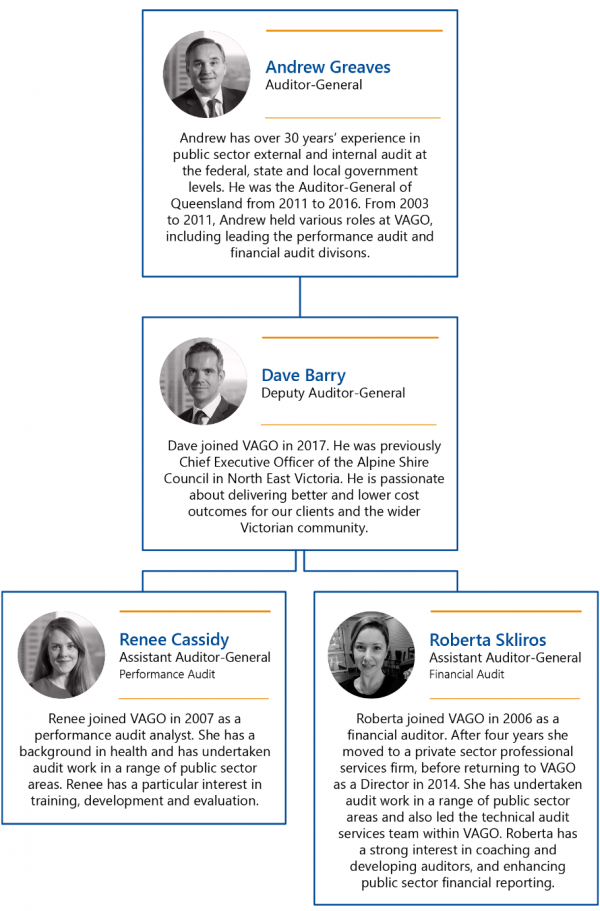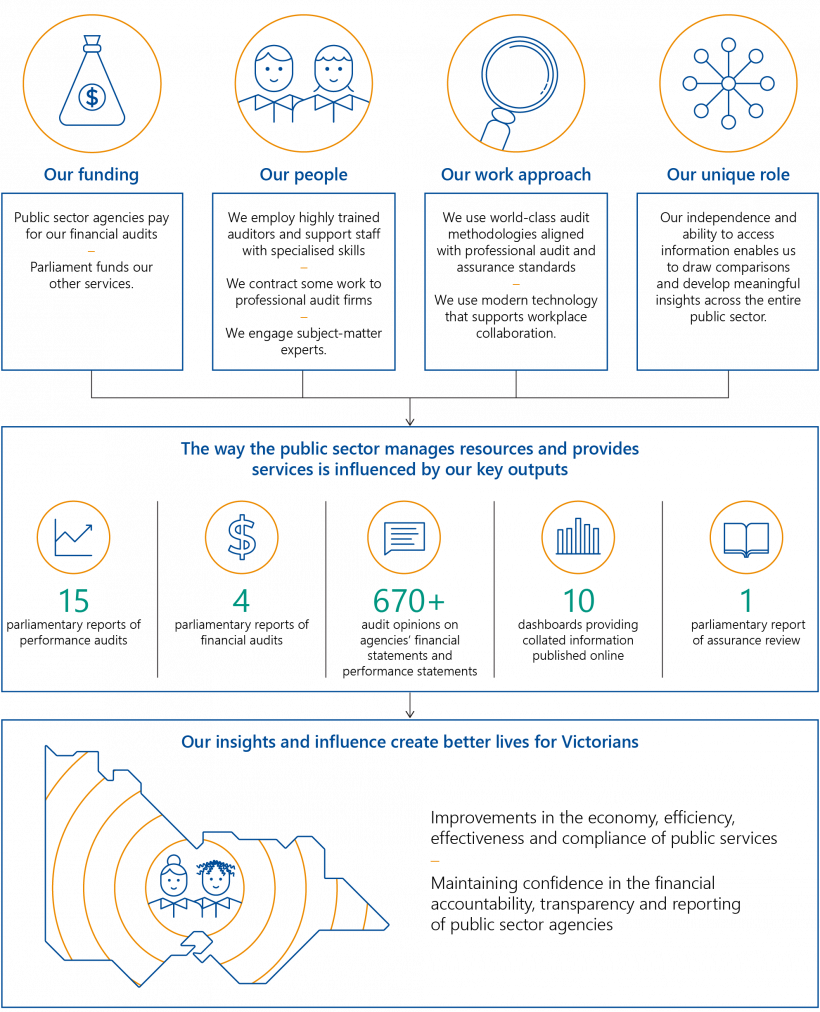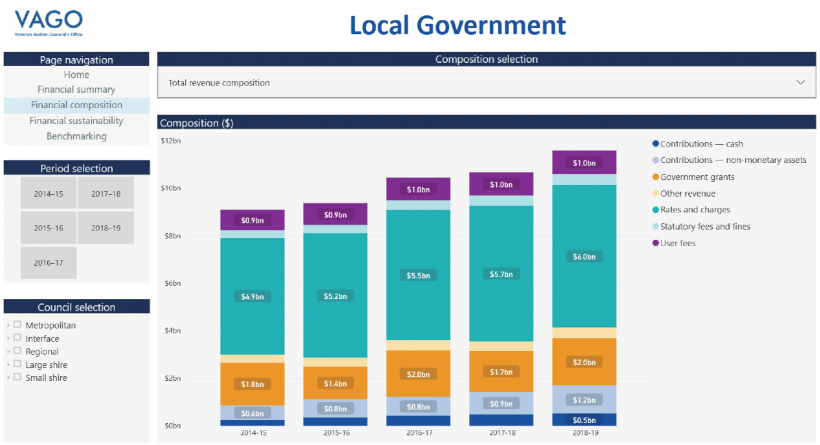Annual Report 2019–20
Foreword
Foreword
A year that began as any other ended in the extraordinary circumstances under which we continue to operate.
Our operations, like those of almost all agencies, have been variously affected by the ongoing COVID-19 emergency, with flow on effects to the delivery of our annual financial and performance audit programs. But most of the disruption we experienced emanated from the deeper disruption to the wider public sector, rather than from any internal constraints or self-imposed restrictions.
Against this background it was pleasing that our strategy over the past three years—investing in our staff, our audit methods, our service delivery models, and our information systems—enabled our business operations to continue almost seamlessly from the day the state of emergency was declared in Victoria. Indeed, we had anticipated it in the weeks leading up to the declaration, and most of our staff began working from home from that day and continue to do so.
To me this exemplifies our resilience as an organisation—resilience built on the two foundational pillars of our strategy: to Invest in our people and to Lead by example.
The emergency has served only to strengthen our commitment to, and our focus on, the health and wellbeing of our staff. It has created a greater sense of connectedness between all of us as we have all galvanised around our mission to deliver reliable and authoritative audit services that in turn lead to beneficial change.
Despite the challenges of remote working, our focus on employee wellbeing and organisational culture has remained our priority throughout the year. In May, we launched our People Matter Action Plan to further our commitment to building an open, constructive and collaborative workplace aligned with our staff-developed values.
As part of our Diversity and Inclusion Plan, we established our Reconciliation Action Plan (RAP) working group. We are proud to work alongside Aboriginal and Torres Strait Islander community members who will provide advice and support as we finalise our RAP, which we anticipate will be approved by Reconciliation Australia later this year.
We have continued also to invest in technology and to leverage this investment to refine and simplify our internal systems and processes, and to augment our audit service delivery models. This investment held us in good stead as we moved to remote auditing. It has also allowed us to maintain, if not strengthen collaboration and teamwork within VAGO.
Finally, it was pleasing to us all, that the four-yearly performance audit of our organisation by the Public Accounts and Estimates Committee (PAEC), tabled in August 2020, concluded that we are ‘operating effectively, economically and efficiently and in compliance with all relevant legislation’. This independent opinion speaks more powerfully than our own assessments could, that the Office is an exemplar for the public sector.
Andrew Greaves
Auditor-General
Data dashboards
Click here to view the dashboard full screen
About this report
This report covers the activities of VAGO for the period 1 July 2019 to 30 June 2020. It is prepared in accordance with the Audit Act 1994 and the Financial Management Act 1994, and complies with the requirements of relevant Australian Accounting Standards and Interpretations, Standing Directions and Financial Reporting Directions.
This report cost $60 000 to produce.
1. About VAGO
VAGO plays a key role in promoting confidence in the public sector.
We conduct audits, reviews and investigations to ensure that public sector entities are transparent and accountable to the Victorian Parliament and the community.
This chapter provides information about our:
1.1 Our role
The Auditor-General is an independent officer of the Victorian Parliament who is appointed on behalf of Victorians to scrutinise how well the government spends public money. VAGO helps to hold the government accountable through our financial and performance audits, assurance reviews and investigations of public sector agencies and our resulting reports to Parliament.
We are part of Victoria’s integrity system. Two principal pieces of legislation govern what we do:
- The Constitution Act 1975 establishes the role of the Auditor-General and gives the Auditor-General complete discretion in how the functions and powers of the role are performed.
- The Audit Act 1994 (the Act) establishes VAGO and the Auditor-General’s mandate. It provides the legal basis for our powers and identifies the responsibilities of our role.
We audit the financial reports of over 560 agencies each year and provide opinions on 110 performance statements. The agencies we audit include government departments, statutory bodies, educational institutions, public health services, water corporations, insurers and local government councils.
We conduct performance audits that assess the effectiveness, efficiency, economy and compliance of government agencies, programs and services. With our follow the-dollar powers, we can audit non-government and for-profit organisations that provide government services under contract. We can also audit the use of government grants by recipients.
Our assurance reviews may focus on either financial issues or matters of performance. They are more limited in scope and examine targeted, time-sensitive issues that do not warrant a full performance audit. They provide a level of assurance which is limited, but still meaningful.
Our unique position and access to information across the Victorian public sector allows us to identify common issues and provide useful insights for parliamentarians, the public and the agencies we audit. We provide recommendations to audited agencies on how to improve services and function more efficiently and effectively.
1.2 Our governance arrangements
Our Strategic Management Group (SMG) governs VAGO’s strategic direction and alignment to its vision, values and purpose. The SMG is collectively responsible for:
- setting and monitoring VAGO’s strategy
- overseeing good governance and a positive organisational culture
- VAGO’s performance from an outcomes and sustainability perspective
- ensuring that VAGO has strong executive leadership.
The membership of the SMG comprises the Auditor-General, Deputy Auditor-General, and the Assistant Auditors-General for performance and financial audit.
1.3 Our operating model
1.4 Our values
In May 2018, we introduced a new set of organisational values. These are:
- respect
- innovation
- collaboration
- accountability
These values shape our work and culture. In 2019–20, we continued to express and embed these values through team building exercises and volunteering opportunities. We also launched a new Employee Recognition Procedure to honour employees for their positive contributions.
To further our 2019–22 Diversity and Inclusion Plan, we established a working group to champion the plan. Initiatives include an audit of our premises to identify barriers to accessibility, Aboriginal cultural awareness training, and the development of our Reconciliation Action Plan, which we will enact in 2020–21.
1.5 Our strategic plan
Our Strategic Plan 2017–2021 sets out our objectives, our directions to achieve these objectives, and measures of what success looks like. This is our third year of operating with the plan. Our four strategic objectives are to:
- Increase our relevance
- Grow our influence
- Invest in our people
- Lead by example
We detail our progress against the plan throughout this report.
|
|
Increase our relevance |
Grow our influence |
Invest in our people |
Lead by example |
|---|---|---|---|---|
|
Our objectives |
Be more relevant by delivering credible and authoritative reports and advice about things that matter and will make a difference |
Be valued for our independence and more influential because of the unique perspectives we provide |
Enable high performance by our people through a supportive culture, professional development and collaboration |
Model exemplary performance in everything we do |
|
Our directions |
Modernise our auditing methods Explore our full mandate Take a longer‐term perspective |
Strengthen our engagement Better leverage our access Increase accessibility to our work |
Be clear about what we stand for Invest in excellence Get the mix right |
Simplify our business Embrace new technology Better intelligence to drive decisions |
|
What success looks like |
Our audit program effort is targeted across efficiency, effectiveness, economy and compliance. The benefits realised by the public sector show an increased return on investment from our audit work. |
More of our performance audits originate from requests from Parliament, the public sector and the public. Use of our reports and associated datasets in government service delivery and for parliamentary purposes has increased. |
Employee engagement has increased. We develop, attract, and retain the talent we need.
|
Workforce productivity has increased. Our internal practices set the benchmark for public sector entities and other audit offices. |
|
Our progress and highlights |
In 2019–20, we delivered an audit program balanced across efficiency, effectiveness, economy and compliance. We used new techniques, such as data envelopment analysis and process mining software, to more thoroughly audit the efficiency of government agencies. We conducted our first assurance review, which found that, of agencies with outstanding audit recommendations, 95.7 per cent said that our audit had added value to their organisation or sector. Our 2020–21 Annual Plan continued to focus on areas of public concern, with further audits planned on sexual harassment, cybersecurity and fraud and corruption. We also added performance audits on the government response to the COVID-19 pandemic. We released an in-house-built data analytics platform to support our audits of financial reports.
|
We continued reviewing suggestions from parliamentarians and the public as part of our annual planning process. We have continued to engage remotely with our stakeholders during the COVID-19 pandemic, and provided remote briefings to parliamentarians. We found that 90 per cent of parliamentarians were satisfied with our service, with none dissatisfied. We expanded our range of data dashboards available to the public. We joined a working group with representatives from government departments to consider alternatives to financial reporting and audit timelines, due to COVID‐19. |
Our employee engagement score this year was 60, down from 65 last year. In response, we engaged an external organisation to facilitate a series of workshops with staff, and created a People Matter Action Plan. We established a diversity and inclusion working group to champion our Diversity and Inclusion Plan. We began procurement for a new Audit Service Providers panel to improve the quality and nature of services delivered. We ran major training initiatives on appropriate behaviour, plain English and Aboriginal cultural awareness. We provided training programs on new accounting standards and our Engage, Plan, Implement and Conclude (EPIC) methodology in financial audit. Our VAGO Social Club has remained extremely active during the COVID-19 pandemic to keep staff motivated and connected. |
Our productivity—the percentage of staff hours charged to our output groups—was 61 per cent (60 per cent in 2017–18 and 60 per cent in 2018–19). We continued our network uplift project, further securing our cybersecurity network and maturing our use of Microsoft Teams. We introduced a unified support desk, providing one number to call for support inquiries across IT, HR, finance, facilities, business support and data analytics. We established a Data Science team, with a focus on exploiting data and statistical analysis to support the performance audit program. We created a Publishing team, embedding a writing coach, editors and graphic designer with auditors to create stronger final reports. We updated our textual and visual style guide, and our audit videos. We delivered several initiatives across the organisation to support governance and improve compliance. |
1.6 Our performance
Every year, we report against the performance measures and targets that we agreed on with the Assistant Treasurer, which are set out in Budget Paper No. 3. We discuss our 2019–20 performance against these measures in the relevant sections in this report. An independently audited performance statement containing this information is also included in Chapter 6. While not required, this audited statement assures readers that our non-financial performance information is reliable, in a similar way that the audit opinion on our financial statements provides assurance.
1.7 Our accountability
We are accountable to the Victorian Parliament and all Victorians for how efficiently and effectively we perform our auditing services and how economically we use public resources.
External audits
The Act requires an independent performance audit of our office be undertaken at least once every four years. The purpose of the audit is to determine whether the Auditor-General and VAGO are achieving their objectives effectively, economically and efficiently and in compliance with all relevant Acts.
PAEC appointed Allen and Clark Consulting to conduct this audit during 2019–20, with the report tabled in Parliament in August 2020. We discuss the audit in more detail in Section 5.
The audit made 31 recommendations We accepted 24 recommendations in full, three in part, three in principle and did not accept one recommendation. We formally monitor our progress in implementing these recommendations through periodic updates to our Operations Committee and Audit and Risk Committee.
We will monitor our progress in implementing these recommendations through periodic updates to our Operations Committee and Audit and Risk Committee.
The tabled report is available on our website.
Victorian Inspectorate
The Victorian Inspectorate (VI) is a key oversight body in Victoria’s integrity system, with the power to scrutinise our activities. It can receive and assess complaints made about us and it can examine our use of our coercive powers. The Inspectorate can also monitor our compliance with procedural fairness and certain sections of the Act.
We have worked with VI to develop a self-reporting tool about the exercise of our coercive power. We did not exercise this power during the financial year.
We understand that VI received one complaint about VAGO from another agency, but it was not within the jurisdiction of VI. We understand that VI did not receive any other complaints about VAGO.
VI made no recommendations to VAGO during the year.
Compliance
As required by the Standing Directions under the Financial Management Act 1994, we publish our Gifts, Benefits and Hospitality Policy and Register on our website.
The Auditor-General’s expenses are monitored by our Audit and Risk Committee and we also voluntarily publish these on our website to enhance transparency and strengthen accountability.
Further details of our accountability mechanisms can be found on our website.
2. Increasing our relevance
In 2019–20, we delivered a balanced audit program and used new techniques to better audit the efficiency of government agencies. However, COVID-19 affected the delivery of our work program with many audited agencies unable to fully engage with our audits, due to their need to respond to the emergency. As a result, we delayed and deferred some audits, tabling just 15 performance audits in 2019–20. This will have a knock-on effect for our 2020–21 program.
We also experienced delays in our financial audits of universities and Technical and Further Education (TAFE) institutions with 31 December 2019 balance dates. Our 30 June 2020 audits in progress have also been significantly disrupted and we expect many of our audit opinions to be delivered later in 2020–21 than in previous years.
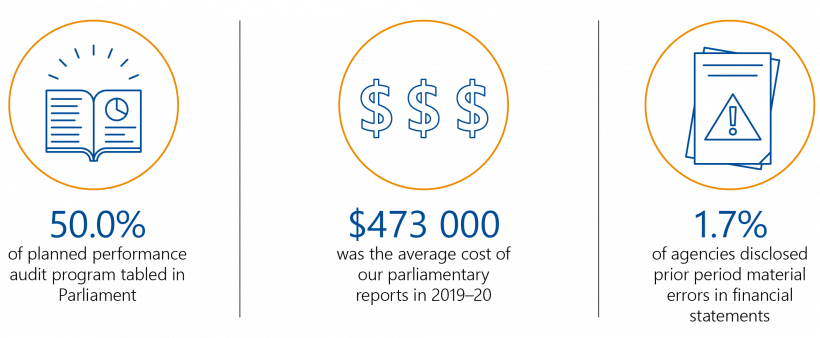
This chapter provides information about our:
2.1 Our performance audit work program
If we are to strengthen accountability and enhance transparency in the public sector, our reports and advice need to be relevant and timely. A key strategy to increase our relevance has been to widen our audit program to cover our full mandate.
Delivery of performance audits
We have continued our focus on maintaining a balanced audit program that reflects our mandate—a mix of audits that examine whether public sector objectives are being achieved effectively, economically and efficiently and in compliance with relevant legislation.
Our latest Annual Plan 2020–21 sets out a three-year performance audit program. This forecast horizon helps to inform Parliament, the public sector and the Victorian community about our short to medium-term goals and priorities. It also provides us with opportunities to undertake early engagement with our stakeholders and improve the scope and focus of our audits. Audited agencies are able to make necessary preparations for scheduled audits well in advance.
We decide which areas to audit by anticipating and responding to current and emerging risks and challenges in the Victorian public sector. A multifaceted approach is taken to identify, assess and prioritise potential topic areas.
This year, our annual plan highlights the impact of COVID-19 and our focus on issues of public concern, including the performance of major infrastructure projects, sexual and reproductive health, fraud control in local government, and reducing the harm caused by gambling.
Parliamentary reporting on performance audits
This year we tabled reports on 15 performance audits in Parliament, four of which we carried over from our Annual Plan 2018–19.
We tabled 11 of the 22 (50 per cent) performance audits listed in our Annual Plan 2019–20. Of the 11 remaining audits, eight were delayed because of the disruption to public sector agencies caused by the COVID-19 pandemic.
Three of these audits—Management of the Student Resource Package, Rehabilitating Mines and Victoria’s Homelessness Response—have since tabled, with the remaining five (Systems and support for principal performance, Early years management in Victorian sessional kindergartens, Clinical governance, Accessibility of tram services, Managing and enforcing infringements) to table in 2020–21.
We had previously delayed our audit on reducing bushfire risks because of the impacts of the 2019–20 bushfire season on audited agencies. These included their recovery work and administrative pressures associated with the Royal Commission into National Natural Disaster Arrangements and the independent inquiry established by the Inspector-General for Emergency Management Victoria in the aftermath of the fires. This audit is scheduled to table in the first half of 2020–21.
We deferred our planned audit on the use of contractors and consultants in the Victorian public service to 2022–23. This was because the Department of Premier and Cabinet (DPC) issued revised guidelines in October 2019 on engaging professional services in the Victorian public service. Departments have been given savings targets for spending on contractors and consultants. DPC will provide a final report on departmental performance in 2022–23.
We removed the audit on the efficiency and economy of Victoria’s public hospitals from our program because of our own resourcing challenges, and our awareness of a range of projects underway in the Department of Health and Human Services (DHHS) and health services to improve efficiency.
Impacts of COVID-19 on our performance audit work program
We were in contact with audited agencies during the early stages of the pandemic to ensure that any changes were clearly communicated. As discussed, we deferred and delayed some performance audits to allow public sector agencies to engage and respond to them at a time when the pressures of the pandemic have eased. In particular, we rescheduled several audits in the health sector, given that this sector is at the frontline of the public health crisis. We carefully considered all requests to delay or defer audits in the short to medium term and have worked with agencies to reschedule our work program to support their COVID-19 response efforts.
Following PAEC’s suggestion, we have included two new performance audit topics in our Annual Plan 2020–21. Our audit on business continuity during COVID-19 will examine whether agencies’ business continuity arrangements enabled them to continue delivering essential public services during the COVID-19 state of emergency. Our audit on the management of spending measures in response to the COVID-19 emergency audit will assess whether agencies’ spending, including spending through the Treasurer’s Advance, has been used for its stated purpose and complies with relevant laws and regulations.
There is limited publicly available information about the process that the government and departments must follow to access funding when responding to urgent and unforeseen expenses, and whether these processes are followed. As a result, we commenced an assurance review focused on the use of emergency funding. The review is scheduled for tabling later this year.
We detailed adjustments to our forward audit program in response to the impact of COVID-19 in our Annual Plan 2020–21, which is available on our website. As discussed, subsequent changes to the program have also occurred.
FIGURE 2A: 2019–20 performance audits tabled by sector
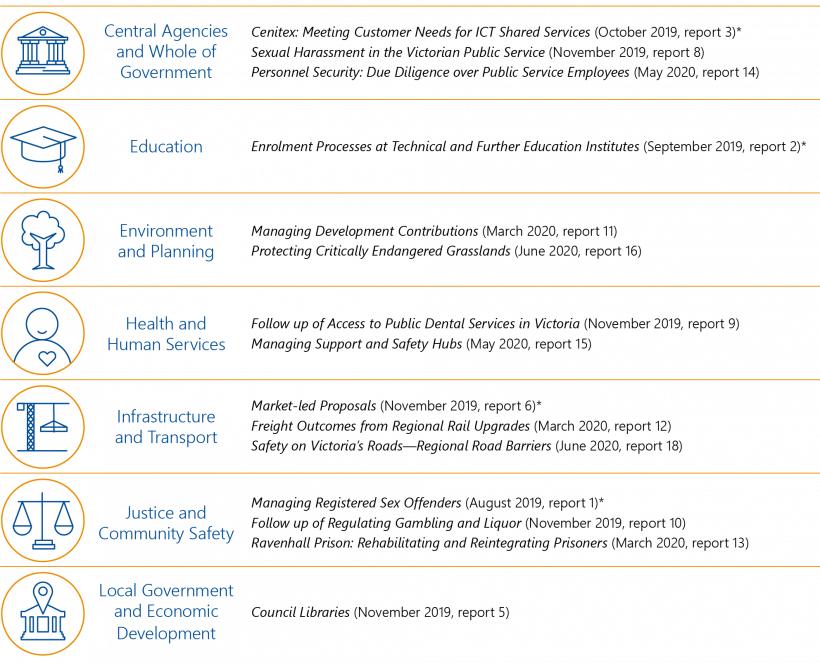
Note: * indicates audits from our Annual Plan 2018–19.
2.2 Our financial audit work program
The independent audit opinions we provide to agencies on their financial statements, and where applicable their performance statements, enhance the credibility and reliability of that information; and allow agencies to discharge their accountability obligation to publish an annual report.
Delivery of audit opinions
In 2019–20 we issued over 560 audit opinions on the financial reports of public sector agencies. We also issued 110 audit opinions on the performance statements of local councils, water agencies and TAFEs.
It is important that our work is reliable and to this end we design our audit procedures to detect material error should it occur. A measure of our performance in this regard is whether the financial statements we opine on have any corrections to take account of previously undetected past errors.
We set a benchmark of 5 per cent for this measure, reflecting that a financial audit opinion can only ever provide reasonable, rather than absolute assurance about the absence of material error:
- 1.7 per cent of agencies disclosed prior period material errors in their financial statements this year, well within our target of less than 5 per cent.
Parliamentary reporting on financial audits
We are required by our Act to report to Parliament each year only on the results of our audit of the State's financial report, prepared by the Treasurer.
While not required to, in addition to this report, we continue to report separately on the results of our audits of local governments, universities and TAFEs.
FIGURE 2B: 2019–20 reports tabled on the results of financial audits
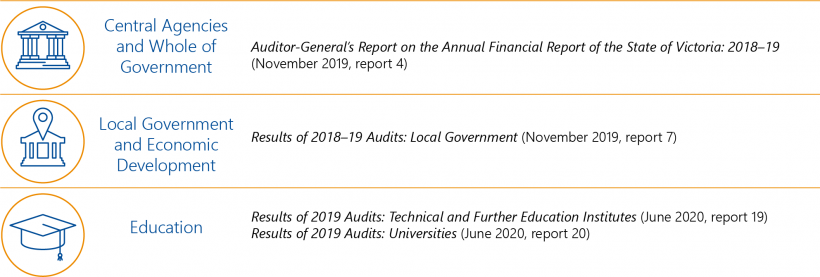
Impacts of COVID-19 on our financial audit work program
While we are equipped to conduct our financial audits remotely, the need for agencies to divert resources to respond to the crisis, combined with the challenges posed by restrictions on movement, access to workplaces and flexible and remote learning arrangements, affected our and agencies’ capacity to achieve predetermined financial reporting and audit timelines.
Our financial audits of agencies with 31 December balance dates were underway when the state of emergency was declared. In response we needed to do extra work to agree disclosures about the COVID-19 emergency and to satisfy ourselves they remained a going concern. This delayed some audit opinions.
We surveyed our clients to set mutually agreed timelines and scaled up our resources to manage the shift in workload.
For our work on agencies with 30 June 2020 balance dates, we joined a working group with representatives from the Department of Treasury and Finance (DTF) and DPC to consider alternatives to financial reporting and audit timelines. Outcomes of this working group allowed us to take a staged approach to financial reporting and audit timelines, focusing on our audit of the Annual Financial Report of the State of Victoria for the 2019–20 financial year and material entities first. This means that we will provide many of our non-material audit opinions later in the 2020–21 financial year when compared to previous years. We will report on this next year.
In addition, our review report on the Estimated Financial Statements for the General Government Sector for the 2020–21 financial year has been delayed until late 2020.
2.3 Efficiency of our services
Services to Parliament
The average cost of our parliamentary reports in 2019–20 was $473 400, which is 10.2 per cent lower than our 2018–19 result and 8.8 per cent lower than our 2019–20 target of $519 000.
However, our target included all of the audits scheduled for 2019–20 in our Annual Plan. The actual result reflects the costs of tabled audits only, of which there were significantly fewer than last year.
This year our performance audits took an average of 10.1 months to complete, the same as last year. This exceeded our target time of 9 months. The causes of these delays included:
- agencies requesting more time to respond to us due to the impact of COVID-19
- our need to replace audit staff due to unexpected leave and departures
- our need to undertake additional work either due to new evidence or to obtain sufficient and appropriate audit evidence to support our conclusions and findings.
The average time to produce our parliamentary reports on results of our financial audits after the balance date in 2019–20 was 5.3 months. We did not meet our target of 5 months. This was due to delays in tabling our financial audits in the university and technical and further education sectors. These delays occurred because we needed to:
- resolve accounting issues regarding the treatment of grants
- work with entities to ensure they adequately disclosed the post balance effects of COVID-19 on their operations.
This had a flow on effect which delayed the finalisation of the two parliamentary reports.
Services to the public sector
The public sector agencies we audit pay us for the financial audit work we do for them. Because our Act provides for us to recover reasonable costs only it is important that we continuously monitor and benchmark our service costs.
The average cost of the audit opinions we issued on financial statements during 2019–20 was $50 200, which was lower than our 2018–19 result of $51 000 and 3.2 per cent lower than our target of $52 000.
We also benchmark our average costs against other State and Territory audit offices with similar mandates:
- the average cost of the audit opinions we issued on state government entities was $64 100, below the ACAG state and territory average of $84 000
- the average cost of audit opinions we issued for local government entities was $47 700, lower than the state and territory average of $58 193.
Because the agencies we audit have statutory timeframes to complete their annual financial statements and to table their annual reports, it is imperative that our work is timely.
- We issued audit opinions for 98.1 per cent of agencies within four weeks of receiving their finalised statements, which is consistent with our performance last year of 98.3 per cent.
- We also issued 92.3 per cent of final management letters to agencies within four weeks of the audit opinion being issued, exceeding our target of 90 per cent.
2.4 Modernising our auditing methods
Our performance audits
In 2019–20, we continued to improve our audit techniques by incorporating new and emerging technology-enabled practices. This included establishing a dedicated data science team with a focus on exploiting data and statistical analysis to support the performance audit program.
Specific examples of statistical and data analysis applied to performance audits in 2019–20 include:
- Council Libraries—calculation of library productive efficiency using data envelopment analysis
- Enrolment Processes at Technical and Further Education Institutes—process mining to understand the difference between policies and processes
- Safety on Victoria's Roads—Regional Road Barriers—program evaluation through modelling fatality and serious injury rates as a Poisson process
- Personnel Security: Due Diligence over Public Service Employees—experimental design and policy breach detection using fuzzy data matching.
Perhaps more important than carrying out analysis directly, the Data Science Team’s second mandate is to transfer knowledge to performance audit team members to enable them to carry out more sophisticated data analysis themselves. This is resulting in more performance audit staff learning and applying skills in statistical analysis and the use of software applications such as Python and PowerBI.
Our financial audits
We have continued to update our new methodology—Engage, Plan, Implement and Conclude (EPIC). EPIC is more streamlined than its predecessor (IPSAM); it focuses on key risks and uses decision aids to help auditors best target their audit program. All audits conducted for the year ending 30 June 2020 applied the EPIC methodology.
We also released our in-house-built data analytics platform Empower, which supports our audits of financial reports. This platform:
- collects and ingests data
- cleanses and checks data for completeness
- transforms data into our VAGO single system
- maps and categorises data for auditors to use
- applies rules and audit logic that had previously been applied manually by auditors
- visualises the results in dashboards for auditors’ consumption.
We produce 54 regularly updated dashboards that cover 30 of our largest audit clients. These dashboards do everything from providing our auditors with the source data they need for their audits, sampling, and planning analytics right through to fully recalculating material classes of revenue.
FIGURE 2C: A deidentified internal dashboard
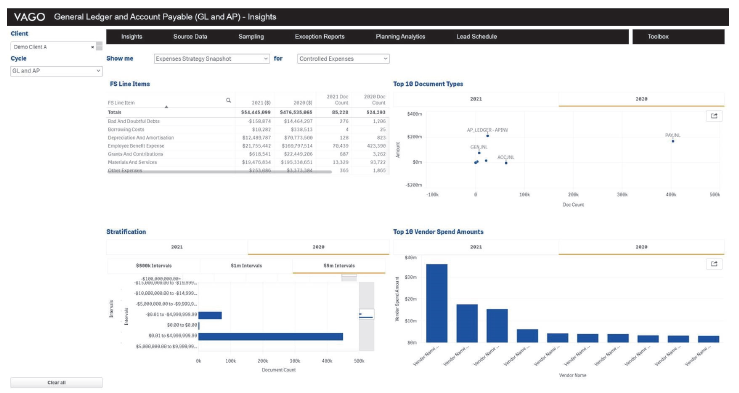
3. Growing our influence
COVID-19 has driven us to find new ways to engage with our stakeholders, such as through remote briefings for parliamentarians.
We tabled several audits in 2019–20 that originated from referrals from parliamentarians and plan to table several more in the coming year.
Our surveys of stakeholders show increased levels of satisfaction with our performance among parliamentarians and chief financial officers (CFOs) of the agencies we audit.
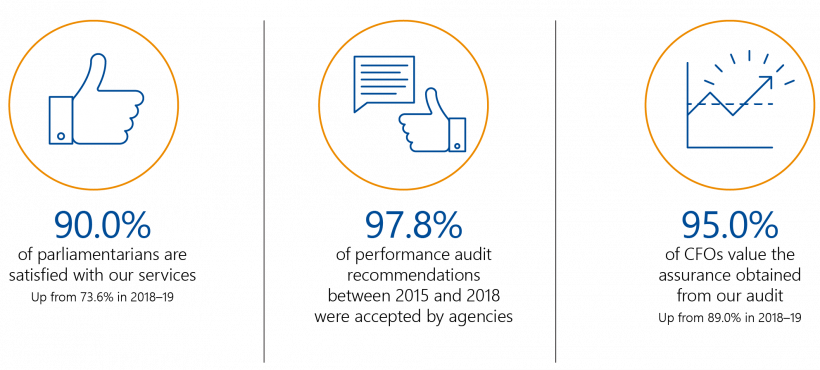
This chapter provides information about our:
3.1 Engaging with our stakeholders
Our primary stakeholders are parliamentarians, the public sector agencies we audit and the Victorian community. We actively engage also with our peers and the accounting and auditing profession.
Parliament
In October 2019 we welcomed the newly formed PAEC and Committee Chair to our office to discuss our annual planning process and role more broadly. The Committee provided valuable feedback on our forward audit program and discussed potential areas of audit interest.
We introduced a virtual parliamentary tabling process for our audit reports to ensure that we meet all relevant requirements and largely maintain our tabling schedule.
We have adapted to the circumstances and have been emailing digital copies of our audit reports, tabling notifications and transmittal letters, instead of providing signed hard copies in person to parliamentary offices. We have also reduced the number of physically printed copies of our reports, which are delivered to the foyer of Parliament House as requested.
As in-person briefings for parliamentarians have not been possible during the pandemic, we have been conducting briefing sessions on tabled reports remotely since May. During these sessions, we provide an overview of our audit findings and respond to the Members’ questions in real time. These briefings occur on the report tabling day and are open to parliamentarians and their staff.
We also responded to inquiries received from parliamentarians throughout the year. On average, we took 15 days to finalise a response, successfully meeting our target of 20 days or less.
Public sector
Our financial and performance audit staff regularly attend and present at forums and conferences for professionals across sectors. In 2019–20 these included departmental CFO forums and industry forums, including:
- Institute for Water Administration Special Interest Group Forum
- VicWater—Future State of Finance Conference
- Healthcare Financial Management Association Annual Conference
- Health Industry Finance Committee meeting
- Victorian Healthcare Association CEO Forum
- Regional Cities Victoria Forum
- FinPro South West Finance Forum
- FinPro Q&A panel sessions for members
- FinPro 2020 Vision - Looking forward clearly Conference
- Prisons 2019 Conference
- Public Sector Innovation Network Forum
- Australian Public Sector Anti-Corruption Conference.
We adapted our annual Audit Committee Chairs’ Forum from an in-person event to our first live-streamed forum. This change was well-received by the 147 attendees, with many advising us that the flexible delivery and ability to attend remotely were positive developments. The forum focused on IT security and resilience, business continuity and revised auditing standards and timelines, with many attendees noting the presentations were focused, succinct, engaging and highly relevant to agencies’ current circumstances in light of the pandemic.
However, COVID-19 did force us to cancel IMPACT 2020, the biennial international meeting of performance audit critical thinkers, which we were due to host in March 2020. Instead, we have uploaded most of the scheduled presentations on our website, including the keynote address from the Hon. Kenneth Hayne AC, former Justice of the High Court of Australia.
While IMPACT 2020 did not go ahead, our Recovering and Reprocessing Resources from Waste audit team was recognised in the performance audit awards category of Excellence. The award recognises the use of exceptional audit methods, attainment of impeccable standards of evidence, presentation of findings and conclusions, and positive and sustained impacts. The awards were judged by Australasian Council of Auditors-General (ACAG) Heads of Performance Audit and the ACAG executive and drew nominees from audit offices across Australia and New Zealand.
Profession and peers
Throughout 2019–20, we welcomed a number of international audit delegations, including the State Audit Office of Vietnam, the New Zealand Office of the Auditor General and the Brazilian State Tribunal of Rio Grande do Sul. These visits provide opportunities for us to exchange ideas and knowledge with other audit offices and strengthen our peer networks and opportunities for collaboration.
Our Financial Reporting Advisory (FRA) team engages with the Australian Accounting Standards Board (AASB) on a regular basis in relation to the application of accounting standards and potential implementation issues in the public sector. This includes providing feedback on various Exposure Drafts released by the AASB via the ACAG network and also representing on AASB’s Project Advisory Panels in relation to projects relevant for public sector entities such as Fair Value Project Advisory Panel and Conceptual Framework Project Advisory Panel.
This year was particularly challenging with four new accounting standards that became applicable for the first time to not-for-profit public sector entities.
These standards were:
- AASB 15 Revenue from Contracts with Customers
- AASB 1058 Income of Not-for-Profit Entities
- AASB 16 Leases
- AASB 1059 Service Concession Arrangements: Grantors.
The FRA team and representatives from our Financial Audit team were part of an AASB working group that considered key implementation issues relating to the application of AASB 15 and AASB 1058 and contributed to the development of the related AASB Frequently Asked Questions.
In addition, the FRA team has worked closely with the Accounting Policy Team at the DTF on financial reporting directions and various policy papers released by DTF during the year in relation to implementing these new accounting standards.
Our Audit Quality (AQ) team engages with the Australian Auditing Accounting Standards Board (AuASB) in relation to the application of accounting standards and potential implementation issues in the public sector. This includes providing feedback on various Exposure Drafts released by the AuASB via the ACAG network.
Our Data Analytics and Systems Assurance (DASA) team hosted a meeting of heads of data analytics from ACAG audit offices in November 2019. The purpose of the meeting was to share how offices are approaching the use of data analytics on audits and to demonstrate our progress with the development and deployment of our data analytics toolset, Empower.
A representative from our DASA team is a part of an Australian Auditing Standards Board (AuASB)-led Project Advisory Group (PAG). The PAG assists the AuASB’s Technical Group in developing the following guidance by drawing on our professional expertise and experience:
- To support the use of technology by auditors in executing audits
- To support auditors in auditing the outputs of technology used by their clients in areas critical to the audit.
3.2 Feedback from our stakeholders
Parliamentarians
We survey parliamentarians every year to understand how well we are serving them. Our 2019–20 survey told us that parliamentarians find our reports and services useful sources of information on public sector performance that help improve public sector administration and assist them in their roles.
Our overall satisfaction rating among parliamentarians improved in 2019–20, with 90 per cent of survey respondents satisfied with our reports and services.
While parliamentarians were generally satisfied with the accessibility of our products and services, the survey responses highlighted that they would like to see more data dashboards and be given the opportunity to learn how to use them. They would also like us to communicate our products and services via social media and in more digestible summaries.
In response, we made several improvements to our parliamentary products.
- We are continuing to build our catalogue of data dashboards and have expanded our social media presence.
- We modernised our video summaries of audits, introducing a refreshed look and animations to better convey our key findings.
- We also developed a refreshed parliamentary report template for release from 2020–21. Our 2020–21 reports include a snapshot summary and a new website format, making them easier to access, digest and share.
FIGURE 3A: Parliamentary satisfaction survey data
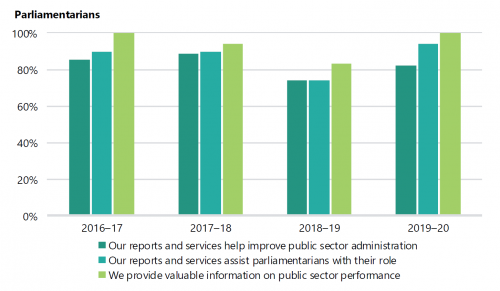
Public sector
We also survey the agencies involved in our performance audits about our process, reporting and value. We aim for our average score across the year to be at least 75 per cent on each of these measures. Figure 3B shows our results for 2019–20 tabled audits. While the score for our process has improved since 2016–17, scores for our reporting and value areas are down from 2018–19. Our overall score has also dropped from 78.0 per cent to 75.3 per cent.
FIGURE 3B: Performance audit survey results
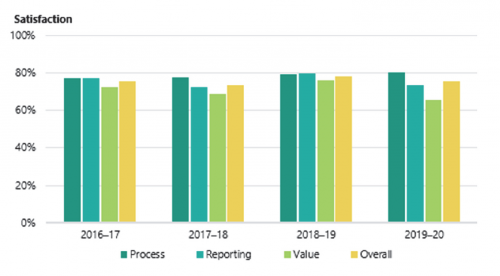
Our scores were affected by the survey response to our Market-led Proposals audit. The audit found DTF and Victoria Police could have been more transparent in the advice they provided to government concerning their assessment of market-led proposals. It concluded that not doing this meant decision-making regarding these significant projects procured outside a competitive process had been compromised.
Victoria Police and DTF did not accept the audit's findings. The audit also made three recommendations to DTF, none of which were accepted. The survey scores for this one audit lay significantly outside the average scores across all audits and therefore negatively impacted the overall results. Excluding the Market-led Proposals survey resulted in our overall score being more consistent with the previous year, 77.2 per cent for 2019–20 and 78.0 per cent in 2018–19.
Our financial audit survey this year continued to show very positive results. As with our performance audit surveys, we asked CFOs about our process, reporting and value. Figure 3C shows some of the highlights of our 2019–20 results.
FIGURE 3C: 2019–20 financial audit survey results
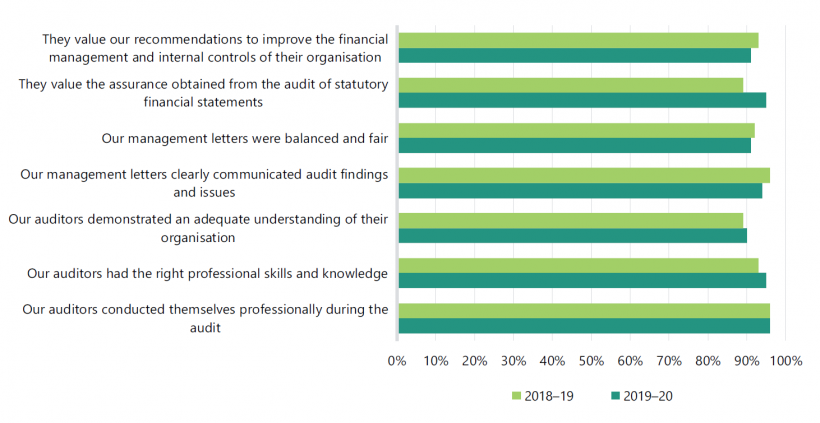
3.3 Where our audit topics come from
We consult the agencies we audit and a wide range of Victorian stakeholders to develop our annual plan of audit topics. We want to ensure that our audit topics reflect issues of concern to parliamentarians and the public, so we aim to increase the number of our audits that originate from these sources.
In 2019–20, we received 138 requests and comments from the public and elected officials, comprising:
- 126 from the general public
- three from local councillors
- eight from state parliamentarians
- one from the public sector
Some of our planned audits relate to issues raised in these referrals, including:
- Fraud control over local government grants
- Supporting students with disabilities
- Major projects performance.
We tabled several audits in 2019–20 that originated from referrals from parliamentarians, such as Freight Outcomes from Regional Rail Upgrades and Safety on Victoria’s Roads—Regional Road Barriers.
We received several requests from parliamentarians and the public to follow up on our Managing the Level Crossing Removal Program audit, tabled in December 2017. We will publish the follow up audit in 2020–21.
3.4 Leveraging our access to data
We are increasing our use of datasets and interactive dashboards that we then make available to the general public. Our dashboards allow any user the ability to download the underlying data. This increases the accessibility of our work and allows people to use our data in a way that is valuable to them.
For example, our Managing Development Contributions audit included an online dashboard that allows a user to find out how much money their council has received in development contributions and how this compares to other councils.
For our assurance review, Responses to Performance Audit Recommendations 2015–16 to 2017–18, we published an online tracker that allows users to find out how 64 agencies have responded to our performance audit recommendations. This is a visualisation of the report appendix to allow the parliament and the public to readily see performance and to allow agencies to compare themselves to others.
Our most viewed dashboard in 2019–20 displayed data from our Results of 2018‒19 Audits: Local Government audit. We also published dashboards on financial data for Victorian public hospitals and water entities, which showed their performance across the last five years.
3.5 Our impact in 2019–20
Parliament
Many of our performance audits have received attention in Victoria's Parliament. In particular:
- our Security of Patients' Hospital Data report became a subject of repeated discussion after a ransomware attack on Victorian hospitals and health services in October 2019
- the Environment and Planning Committee made multiple references to our Improving Victoria's Air Quality report in its discussion of the Environment Protection Authority's (EPA) intention to expand the network of fixed air monitors 'in line with recommendations from the independent inquiry into the EPA and from the Auditor-General.'
- the November 2019 Parliamentary Inquiry into recycling and waste management quoted our Recovering and Reprocessing Resources from Waste audit heavily (over 40 mentions). According to the Inquiry report, ‛…in the Committee’s view, addressing the concerns raised by the Auditor-General should be a priority for the Victorian Government and a review of progress made should be undertaken… to ensure that improvements are apparent and are continuing to be made’.
In addition, PAEC tabled a follow-up inquiry into our Meeting Obligations to Protect Ramsar Wetlands report. This inquiry looked at the progress that has been made implementing audit recommendations, identified issues with implementation, and investigated new issues that have arisen since we tabled the report.
Our reports Access to Mental Health Services and Child and Youth Mental Health received Parliamentary attention throughout the year. They were also considered in the Royal Commission into Mental Health, for which the Auditor-General was requested to appear to provide a briefing on our work. The Royal Commission's interim report made significant references to our audits, delivering recommendations that are consistent with those made in our two reports.
Public sector
Agency responses to performance audit recommendations
In 2019–20, we conducted our first assurance review, Responses to Performance Audit Recommendations 2015–16 to 2017–18. The review replaced the annual follow-up survey we have been conducting since 2015–16.
The review assessed whether agencies have effectively addressed our past performance audit recommendations. It involved 64 agencies with 465 outstanding recommendations from 44 performance audits over a three-year period.
An assurance review compels agencies to provide requested information to us using the same powers in the Act as for an audit. Participation in our previous surveys was not mandated and as such our response rates were lower.
FIGURE 3D: Agency responses to assurance review
| Metric | Result |
|---|---|
| Assurance review survey response rate | 100 per cent |
| Audit recommendations accepted by agency | 98 per cent |
| Audit recommendations reported as implemented | 60 per cent (a further 38 per cent underway) |
| Days on average to implement a recommendation after the audit tabled | 457 days |
| Agencies that reported the audit added value to their organisation | 96 per cent |
Source: VAGO, Responses to Performance Audit Recommendations 2015–16 to 2017–18.
We also use the results of the survey, combined with information from our 2018–19 survey, to report to Parliament in our Budget Papers the percentage of accepted performance audit recommendations that audited agencies report as implemented across a two‐year period. In 2019–20 we achieved 80.8 per cent, which exceeded both our target of 80 per cent, and our 2018–19 result of 78.4 per cent.
It is pleasing that agencies take action where they agree with our audit recommendations, albeit at times slower than they planned to.
But to be fully effective requires that agencies first agree to our recommendations. To this end we take considerable effort to analyse the root causes of the issues we identify in our audits and strive to develop practical recommendations that address these root causes. That we are successful in this endeavour can be measured by the percentage of our recommendations with which agencies agree and commit to take action.
During 2019–20 we made 268 recommendations, and with the singular exception of our November 2019 report on Market-led Proposals, 97 per cent of these recommendations were accepted.
Disappointingly, DTF disagreed with the three recommendations we made in our report, all of which were designed to enhance the transparency and improve the effectiveness of the market-led proposal process. It did so on the basis that ‘the Report does not provide a reasonable basis to support any of the recommendations’ as set out by the Secretary of DTF in his response to our report, which was included in full.
The responsibility for balance, fairness and accuracy of the DTF response rests with the Secretary. It was from these perspectives that the Auditor-General wrote to the Secretary before he tabled the report to draw his attention to our concerns with his response. One of our major concerns was the assertion that we had not substantively engaged with DTF on the audit. The Auditor-General expressed his view to the Secretary that this was 'demonstrably unfair and misleading' which he supported with key facts about the nature and timing of engagement. The Auditor General also shared his concerns with the Treasurer.
Agency responses to financial audit recommendations
Our financial audits have also made a measurable impact on internal controls this year. Part of our financial audit process is to issue management letters to agencies highlighting the internal control weaknesses and other matters we find and make recommendations to resolve them. Agencies respond to these letters with their intended actions. This year we continued to see improvements in the number of issues being resolved, particularly in the education sector.
FIGURE 3E: Percentage of resolved issues from prior years
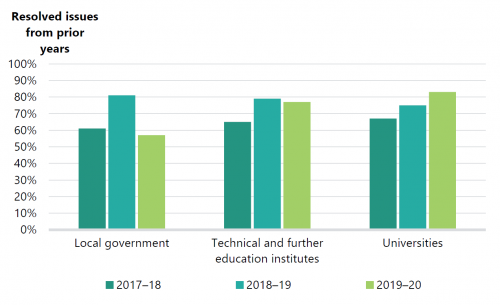
We collect data on the resolution of issues from prior years across all sectors and are looking to report this information more broadly going forward.
Over the past three years, across all sectors, the average number of open issues remaining at the end of the year has steadily declined. This demonstrates the commitment of agencies' management to a strong control environment and the positive, long-term impact of our approach.
4. Investing in our people
In our Strategic Plan, we set ourselves the objective to enable high performance by our people through our supportive culture, professional development and collaboration.
Our employee engagement score dropped to 60 from 66 last year. In response, we engaged in a series of workshops with staff and created a People Matter Action Plan.
We delivered 475 hours of training in 2019–20 to increase staff capability and knowledge, an average of 36 hours for each full time staff member. Women made up 55 per cent of our workforce in 2019–20 and 42 per cent of our executives.
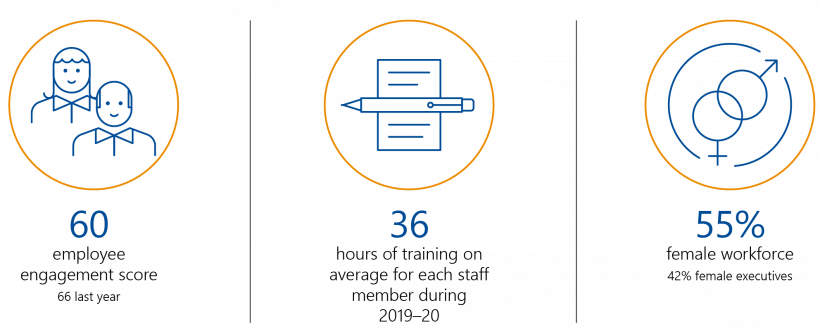
This chapter provides information about our:
4.1 Our workforce
Our employees
Appendix A includes a profile of all VAGO employees. The workforce profile shows our employees by age, seniority, whether they are part-time or full-time, on fixed term or ongoing contracts, and by gender.
As of 30 June 2020, 55 per cent of our workforce were women. However, women made up 100 per cent of our part-time workers (unchanged from 2018–19) and 42 per cent of our executives (up from 38 per cent in 2018–19).
Our gender pay gap is 2.7 per cent in favour of women.
Ensuring the health and wellbeing of our staff has been our main priority during the COVID-19 pandemic. We surveyed our staff in April to get a greater understanding of their existing health and wellbeing status and potential needs going forward. A 96 per cent survey response rate provided us with valuable information about how our staff were feeling about working from home, staying connected with their colleagues and their ability to disconnect from work and recharge. We also asked our staff to tell us how we could best support them during this time.
Staff also completed an online self-assessment regarding their comfort and safety at home to ensure that their home office equipment and technology solutions meet their needs.
We adapted our professional learning and development program content for virtual learning where possible, and staff have continued to utilise our online booking system. We also introduced a comprehensive suite of online health and wellness activities, such as virtual yoga and fitness classes and mindfulness and nutrition advice, to assist in maintaining staff mental and physical health while working from home.
Our Social Club has also remained extremely active, and has initiated a wide range of online games, cultural discussion topics, ‘lunch and learn’ sessions and trivia to keep staff motivated and connected.
From March, we began live streaming our fortnightly briefings and quarterly business unit forums to ensure that our communication lines with staff remained open. We also facilitated more regular engagement with our audit service providers, meeting virtually, bi-monthly in the lead up to the end of the financial year. We also introduced a special leave entitlement for all employees in accordance with Victorian public service guidelines. This entitlement provided staff who were directly or indirectly affected by COVID-19 due to school or childcare centre closures, restrictions on care arrangements, or the requirement to quarantine or self-isolate, with the ability to access leave for these purposes.
Audit service providers
To help us deliver more than 560 annual financial audits for public sector organisations, we employ a panel of audit service providers to perform audit work on our behalf.
Given the recent rapid changes occurring in the audit profession, driven by new technology and broader considerations of the independence of auditing firms, we judged this year that our audit service providers panel’s requirements and processes were no longer fit for purpose.
As a result, we went to market in 2019–20 to establish a new panel to improve the panel’s composition, engagement process, allocation method, performance management and the quality and nature of services it delivers. During this process, we placed a greater emphasis on data protection and governance, and firm quality control and assurance.
The objectives of the new panel arrangement are to:
- obtain access to a consistent level of audit quality and value-for-money audit services
- achieve continuous improvement towards best practice in financial audit services
- engage service providers that have a strong cultural fit with VAGO and develop strong relationships with them
- achieve process efficiency and effectiveness.
The new audit service providers panel is expected to be finalised in the 2020–21 financial year.
4.2 Improvements in our workplace culture
Despite the challenges of the COVID-19 crisis, our senior leadership team continued to focus on prioritising employee experience and organisational culture throughout the year. During this period of change and transition, we curated and created resources to help restore wellbeing, including webinars, virtual yoga, games and quizzes. We discussed how different communication tools help build deeper connections within teams and focused on how empathetic leadership can be used to improve engagement and productivity. We revised our procedure to recognise and reward staff who demonstrate our values, which encourages our staff to tell others about those who perform above expectations.
In May 2018, we launched a new set of values (respect, innovation, collaboration and accountability), developed by staff. In 2019–20 we further embedded these values in our organisation.
We held a values month in November 2019, which involved various activities where we expressed our unique skills, talents and experiences and took the time to get to know more people across the organisation.
For example, we assigned people to random teams to construct bridges out of wooden sticks and held a ceremony to judge the winner.
FIGURE 4A: Two of the contending bridge designs

Our teams spent a day volunteering at Brotherhood of St Laurence to sort donated goods and were educated about the operations of the warehouse and how it improves the lives of disadvantaged Victorians.
We also volunteered to help prepare and serve over 400 nutritious, three course meals at the Sacred Heart Mission. We collected non-perishable goods for Australia’s largest food relief organisation, Foodbank, which contributes to emergency grocery hampers for struggling families. We volunteered our time at working bee for Cubbies Adventure Playground, repairing cubbies for kids.
People Matter Survey
We received our 2019 People Matter Survey results in mid-2019 and analysed them to understand how we could improve the everyday experience of our employees. Our employee engagement score was 60 per cent, down from 66 in 2018, while our employee satisfaction was 60 per cent, down 5 per cent from the previous year. The areas that were identified for attention included appropriate behaviour and avenues of redress, wellbeing and workloads, and diversity.
We engaged an external organisation to facilitate a series of workshops in October 2019 to explore themes including change management, appropriate behaviour and sexual harassment, workload stress, and reward and recognition. In these workshops, staff shared their ideas on what we should do to improve everyone’s experiences at work.
As a result of these engagement activities, we developed and launched an employee-led People Matter Action Plan in May 2020 to further our commitment to building an open, constructive and collaborative workplace that is aligned with our core values. The plan outlines key objectives and strategic initiatives, including values-led leadership, effective change practices, creating a culture of safety, balancing work with life and celebrating success.
To demonstrate best practice and accountability, we published our People Matter Survey results on our website in November 2019.
We plan to participate in the 2020 survey, which was delayed by the VPSC due to the present emergency.
Diversity and Inclusion Plan
We are in year two of our 2019–22 Diversity and Inclusion Plan and are continuing our focus on developing awareness and maturity of diversity matters. We recognise that diverse and inclusive workforces have a better capacity to meet business needs, are adept at providing different ways of looking at work issues and drive higher innovation and productivity.
In 2019–20, we established a diversity and inclusion working group who met regularly to work through and implement the plan.
One element of our 2019–22 Diversity and Inclusion Plan is our aspiration to provide an inclusive workplace that fosters respect, understanding and unity between Aboriginal and Torres Strait Islander peoples and non-Indigenous Australians. Our role working across the public sector, necessitates that we develop the skills to recognise and value the experiences, perspectives and cultures of Aboriginal and Torres Strait Islander peoples.
To achieve this, a subset of the diversity and inclusion working group was formed— our Reconciliation Action Plan (RAP) working group, comprising senior executive and non-senior executive staff as well as Indigenous community members. We are proud to work alongside three Aboriginal and Torres Strait Islander community members who will provide advice and support as we finalise our RAP. The RAP is a living document that we anticipate will be approved by Reconciliation Australia later this year. Once approved, the RAP committee will be responsible for its implementation alongside the other initiatives in our 2019–22 Diversity and Inclusion Plan.
We purchased and now display local Aboriginal and Torres Strait Islander artwork in our office to demonstrate respect and awareness that VAGO exists on Wurundjeri land. We also supported staff to attend a film screening, Connection to Country as part of VAGO's National Aborigines and Islanders Day Observance Committee (NAIDOC) week celebrations.
We ran two Aboriginal Cultural Awareness training sessions for staff prior to commencing remote work. As this training is most effective when in a face-to-face environment, we decided to postpone the remainder of these sessions due to COVID-19. Despite this, we continue to celebrate days of significance while working remotely. We have recently acknowledged National Reconciliation Week and Refugee Week with overwhelming engagement from staff discussing diversity and inclusion, demonstrating their commitment to enacting change in this space.
We also had guest speakers throughout the year, aligned to our values and 2019–22 Diversity and Inclusion Plan. Jess Perrin from Infoxchange talked about social impact programs and digital inclusion. Beau Vernon, a motivational speaker and Director of Interact Australia, talked about how his experience of quadriplegia strengthened his resilience and ability to help others.
We conducted an accessibility/ability review of our premises to identify barriers to accessibility and any adjustments that need to be made to ensure our offices are accessible to all. Due to the COVID-19 pandemic, the actions arising from the review have been postponed to early 2021.
4.3 Improvements in our skills
In 2019–20, we continued our focus on building a workplace culture that fosters continual growth and development, collaboration and innovation. To support this, employees undertook mandatory training on Microsoft products Power BI, Word, Excel and Teams to build business efficiency.
In addition, we held a number of workshops and seminars to increase staff capability and knowledge, such as appropriate behaviour training, manager foundations, writing skills, fraud and corruption awareness, and a suite of technical training for performance and financial audit staff.
In total, we delivered 475 hours of training in 2019–20 to increase staff capability and knowledge, an average of 36 hours of professional development for each full time staff member.
Financial audit
Every year we invest time in upskilling our financial audit staff via training on relevant topics. This year was particularly challenging, with four new accounting standards becoming applicable for the first time to not-for-profit public sector entities.
This year we invested time in the development of new and improved ‘learning aids’ for AASBs. The learning aids included:
- flowcharts to help navigate through each standard
- guidance to support the learning aid, including key judgement areas in each standard
- audit worksheets to assist audit teams document conclusions when assessing transactions impacted by the new standards
- illustrative examples to demonstrate practical application of the new standards
Following the release of learning aids, information sessions were held to assist audit staff on:
- how to navigate through the learning aids; and
- key judgement areas and related guidance in each of the standard.
Performance audit
We also collaborated during the year with the Canadian Audit and Accountability Foundation (CAAF) and audit offices around Australia to develop and deliver performance audit training. Attended by participants from several Australasian jurisdictions, the following training was delivered:
- leading successful audits (three days)
- audit evidence and reporting (two days).
5. Leading by example
Our workforce productivity increased slightly in 2019–20. We continued our network uplift project and also delivered initiatives to support governance and improve compliance.
PAEC commissioned a quadrennial performance audit of our organisation. The audit was positive overall, and made 31 recommendations for improvement, all but one of which we accepted either in full, in part or in principle.
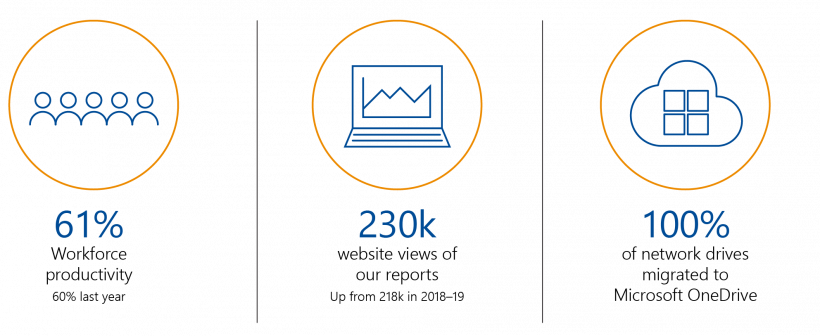
This chapter provides information about our:
5.1 Our technology and data protection
In the second year of our two-year information technology (IT) strategic plan, we:
- made use of our access to cross-government datasets to provide new insights
- streamlined and increased automation
- further invested in cloud technology
- further integrated our business systems
- shared information to improve our practice
- leveraged the DPC state-purchasing contract to acquire cost-savings around licences and products.
Our IT projects in 2019–20 focused on two keys pillars—cybersecurity and user experience.
Cybersecurity
Stage 2 of our network uplift project delivered north–south network security to protect workloads in Microsoft Azure, joined our firewalls and switched to internal authentication, and further secured our environment against the risk of malicious network activity.
We secured privileged access to provide time-based and approval-based role activation to mitigate the risks of excessive, unnecessary or misused access permissions on our resources.
We further reduced the risk of losing access and control over our Office 365 environment by ensuring we have a backup of our data residing in Office 365, which includes SharePoint, Exchange, OneDrive for Business and Teams and is secured against data loss and corruption using Veeam Backup for Office 365 software.
User experience
As a part of our COVID-19 response and recovery, we mobilised a project team to ensure that all of our staff have the best available IT equipment to work comfortably and uninterrupted during this period. Within two weeks of remote work commencing, the team surveyed all staff on their requirements, sourced equipment, hired vehicles and coordinated pickup and delivery of required equipment to 165 homes.
We have continued to mature our use of Microsoft Teams, migrating our external phone numbers from Skype for Business and deploying five new Surface Hub devices in our large meeting rooms. As part of this process, we:
- now use the Microsoft Teams application on all Surface Hubs and mobile devices
- removed all desk phones and provided Bluetooth headsets as required
- decommissioned Skype for Business
- removed old software and hardware from meeting rooms and laptops
- implemented an analogue (public switched telephone network) phone and line for our first aid room.
Leveraging off our Microsoft Teams investment, we also standardised our support functions by creating a unified support desk. This involved introducing one phone number for staff to call for support inquiries across IT, HR, finance, facilities, business support and data analytics, and included a review of all shared mailboxes and service desk email addresses.
VAGO received positive feedback from the Commercial Executive with Microsoft, in relation to our investment in and management of Microsoft 365 licenses. After a tour of our office he wrote that he valued, ‘the opportunity to see’, for example, ‘how extensively Teams is being used as a collaborative tool across VAGO.’
Redevelopment of VPN infrastructure
In 2019–20, we fully migrated our virtual private network (VPN) infrastructure to Azure. This has provided us with a highly available environment and enabled modern authentication processes across all of our Microsoft applications.
Impacts of COVID-19 on our business systems
Our IT systems and software in place prior to the onset of COVID-19 meant we were able to transition to a working from home environment quickly. We began talking to our staff regarding the possible implications of COVID 19 at the end of February. We were the first public sector agency to have all of our staff working from home on 16 March 2020, delivering laptops to the homes of staff where required.
Operationally, we understood our staff equipment and internet connectivity needs by using Microsoft Forms to survey our workforce within a week of the shift to remote working. Over 95 per cent of staff responded within one day of the survey being issued. We used collaborative tools on SharePoint to track the purchase of over 300 new items and schedule the delivery of 700 items to our staff, from second monitors, to desks, chairs cables, and keyboards. We used Google to optimise our delivery routes and used our Flexicar app to book delivery vans with no human contact. Group chat was used to ensure our four staff making deliveries to 165 homes, travelling 1 740 kilometres, were able to do so on time and contact-free within two weeks of staff commencing working for home.
We have provided comprehensive COVID-19 updates to staff outlining our response and planned actions and began live streaming our all staff briefings which remain accessible after the event. These measures have ensured we remain well connected with our staff during this challenging time. We used Microsoft Stream to ensure our staff could watch, and re-watch, any live event at any time.
5.2 Improving our communication
As an organisation that works in the public interest, we want all members of the public to be able to access our work and easily understand our findings and recommendations.
All of our staff take part in compulsory training on plain English, and auditors work closely with our communications and publishing teams to prepare materials for publication.
At the start of 2019–20, we made several changes to embed principles of clear communication in our organisation. These included:
- hiring a senior writing coach to help auditors tell the story of their work
- hiring a graphic designer to better present our data and findings
- embedding our editors within audit teams to create a stronger final report.
These changes have led to leaner reports that more directly tell the public what we found and what it means for them. Our audits have found a wide audience, with over 230 000 views of reports on our website in 2019–20, and over 15 000 views of our audit videos. The below graphic shows the audits that had the largest audience engagement over the year.
FIGURE 5A: Most viewed audits
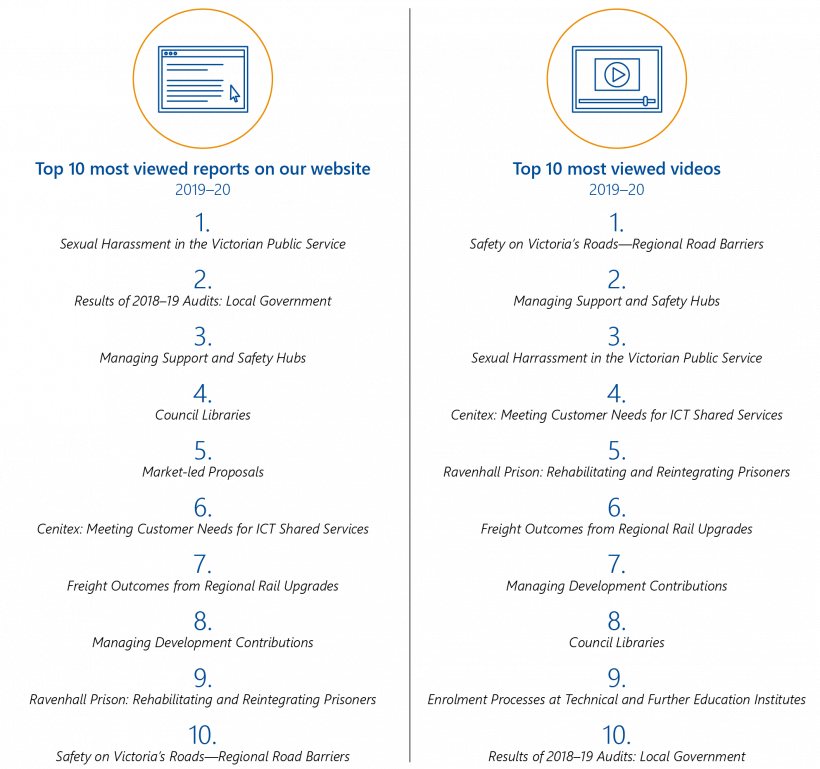
We have also updated our written and visual style guide to make our reports more accessible. This has involved making our audit videos clearer and more dynamic and updating our report template.
Changes to our audit videos have already led to positive results—the two most watched videos of 2019–20 were created in our new style. In addition, our analysis has found that since updating our audit videos at the start of 2020, the average viewer watches 58.2 per cent of the video, compared to 43.5 per cent for videos watched in 2018–19.
In 2020–21, we will introduce further improvements to our reports, including adding an audit ‛snapshot’, which includes all essential information on one page.
5.3 Workforce productivity
We measure our workforce productivity as the total percentage of available paid staff hours that are charged to our output groups—audit opinions on financial and performance statements, parliamentary reports and parliamentary services.
Our productivity this year was 61 per cent, in line with our target and above our 2018–19 result of 60 per cent. Staff are able to track their productivity and that of their team members via live self-serve business intelligence dashboards.
5.4 Compliance initiatives
We have continued to enhance and mature our governance and compliance systems. We have ensured that we are meeting our obligations under the Financial Compliance Management Framework, the Victorian Government Risk Management Framework, and the Victorian Protective Data Security Framework.
As part of our ongoing commitment to exemplary performance, complaints can be submitted anonymously through our website, or received through direct communication with our audit teams. When receiving a complaint our process is to assess, investigate, respond to and remedy complaints to the best of our ability. In 2019–20 we received three complaints relating to the conduct of an audit, all of which were responded to within the reporting period of 28 days.
We have delivered several initiatives across the organisation to support governance and improve compliance:
- We launched a self-service business intelligence portal for staff to manage their teams’ productivity, production hours and actual costs against budgets for audit projects. We will continue to expand our business intelligence maturity, to provide a broader suite of operational and financial data to support our performance reporting.
- We created a centralised register of all key documents, including policies, procedures, manuals, forms, reports, and plans.
- We updated our public interest disclosure policies and procedures to reflect the amended legislation.
- We updated our fraud risk assessment and continued to execute and implement actions from our refreshed Fraud and Corruption Control Plan.
- We launched new training modules on fraud, corruption and conflicts of interests for all new starters and as a refresher for existing staff.
- We continued to strengthen and mature our risk management and governance frameworks, including strengthening our project management discipline through a centralised project portfolio tool to support effective project risk and issue management, as well as promoting better transparency, reporting and oversight.
- We restructured our Office of the Auditor-General business unit to bring together specialist audit support teams, including Audit Quality, Financial Reporting Advisory, Data Analytics and Systems Assurance, and Data Science.
5.5 Assuring our audit quality
Public interest is served by the consistent performance of quality audit engagements. We are committed to continuous improvement of our systems of quality management in accordance with the six elements of quality provided in the Auditing Standard ASQC1 Quality Control for Firms that Perform Audits and Reviews of Financial Reports and Other Financial Information, Other Assurance Engagements and Related Services Engagements.
FIGURE 5B: Elements of quality
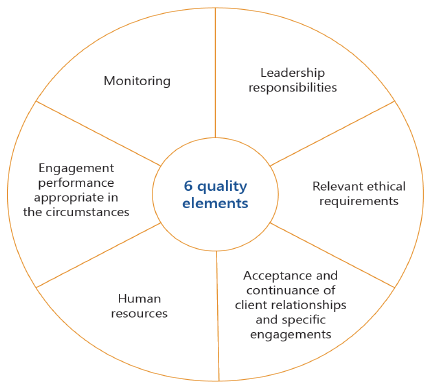
Leadership responsibilities
Our strategic management group fosters a continuous improvement culture at VAGO. It is committed to the delivery of effective and efficient audits.
Relevant ethical requirements
We have a continuous program to ensure our staff understand our ethical requirements. Our policies and processes facilitate and monitor our compliance with Australian Auditing Standards and:
- APES 110 Code of Ethics for Professional Accountants, which requires a member to act with integrity, objectivity, professional competence, and professional behaviour
- the requirements of the Code of Conduct for Victorian Public Sector Employees of Special Bodies and Public Administration Act 2004, which requires us to act with integrity, impartiality, accountability, respect, leadership, and human rights
- the Standing Directions under the Financial Management Act 1994, which provide policies on gifts, benefits and hospitality.
Acceptance and continuance of client relationships and specific engagements
We undertake financial and performance audits, assurance reviews and investigations of public sector entities as permitted under our Act. Each year we publish our work program in our Annual Plan.
We are not permitted to undertake non-audit services.
Human resources
We recognise the importance of assigning an engagement team with sufficient capacity and capability aligned to the specific risks/requirements of each engagement. We achieve this through our resourcing strategies, use of experts, recruitment practices and continuing professional development.
Engagement performance appropriate in the circumstances
Our audits are supported by methodologies, policies and tools. We are focused on delivering next-generation audit solutions underpinned by data analytics and innovative audit tools that are compliant with the auditing standards. Our audit processes have clearly defined roles and responsibilities and review and consultation requirements aligned with audit risk.
Monitoring
Our monitoring programs focus on continuous improvement. The results of our quality assurance review programs, client and staff surveys and audit complaints are assessed to identify areas where we can further improve our methodologies, tools, and capabilities of our engagement teams.
Each performance audit engagement leader is now to be subject to an audit review at least once every two years over a four-year cycle. The current review program is in progress.
Each year we conduct a quality review of a targeted selection of completed financial audits as part of our assurance program, to measure our level of compliance with the requirements of applicable Australian Auditing Standards, Australian Accounting Standards and Accounting Professional Ethical Standards.
This year, our reviewers identified that some aspects of two of the twelve audit files reviewed had material process departures from professional standards. While this is not optimal, we note our result is better than industry published rates of 26 per cent of reviewed audit files having material departures from professional standards. Nonetheless we undertook a root cause analysis of the departures and developed and are implementing remediation strategies to address the issues identified.
PAEC external audit
The Audit Act requires an independent performance audit be conducted of our office at least once every four years. The purpose of the audit is to determine whether the Auditor-General and VAGO are achieving their objectives effectively, economically and efficiently and in compliance with all relevant Acts.
PAEC appointed Allen and Clark Consulting to conduct this audit during 2019–20, with the report tabled in Parliament in August 2020.
The report was positive overall, concluding that:
‘The Auditor-General and VAGO are operating in compliance with all relevant Acts of Parliament. Moreover, the Auditor-General and VAGO are, in all material respects, operating effectively, economically and efficiently and achieving their objectives in compliance under the Act’.
A key finding of the audit was that we have a strong cultural understanding of the importance of maintaining independence, which is underpinned by appropriate policies and methodologies. Audit staff were found to conduct audit engagements professionally and respectfully and understood the need to add value by helping to improve the effectiveness and efficiency of the public sector.
Our methodologies for both performance audits and financial audits were found to be comprehensive and regularly reviewed to ensure compliance with the Act and requisite standards. Our systems and processes efficiently and effectively support us to set, manage and monitor audit, divisional and office-wide budgets.
The audit made 31 recommendations. We accepted 24 recommendations in full, three in part, three in principle and did not accept one recommendation. We formally monitor our progress in implementing these recommendations through periodic updates to our Operations Committee and Audit and Risk Committee.
The tabled report is available also on our website.
6. Performance statement
Declaration in the performance statement
In our opinion, the measures used and results reported in the accompanying performance statement of the Victorian Auditor-General’s Office in respect of the 2019–20 financial year are presented fairly, and are consistent with the Standing Directions under the Financial Management Act 1994.
The statement includes the 2019–20 performance measures agreed with the Assistant Treasurer as set out in Budget Paper No. 3, actual and comparative results achieved for the financial year against targets where applicable, and explanations of any significant and/or material variance between the actual results and performance targets.
As at the date of signing, we are not aware of any circumstance which would render any particulars in the performance statement to be misleading or inaccurate.
We authorise the attached performance statement for issue on 4 September 2020.
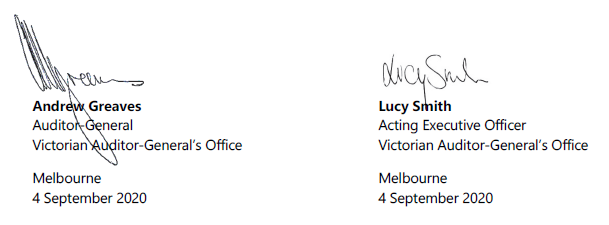
Click the link below to download a PDF copy of the performance statement.
7. Our financial management
Click the link below to download a PDF copy of our financial statement.
Appendix A. Workforce profile
Click the link below to download a PDF copy of our workforce profile.
Appendix B. Workplace health and safety
Click the link below to download a PDF copy of our workplace health and safety statement.
Click here to download our workplace heath and safety statement
Appendix C. General executive information
Click the link below to download a PDF copy of our general executive information.
Appendix D. Audit and risk management
Click the link below to download a PDF copy of our audit and risk management statement.
Click here to download our audit and risk management statement
Appendix E. Environmental management
Click the link below to download a PDF copy of our environmental management statement.
Click here to download our environmental management statement
Appendix F. Policies and compliance
Click the link below to download a PDF copy of our policies and compliance statement.
Click here to download our policies and compliance statement
Appendix G. Additional information available on request
Click the link below to download a PDF copy of our additional information.
Appendix H. Disclosure index
Click the link below to download a PDF copy of our disclosure index.

